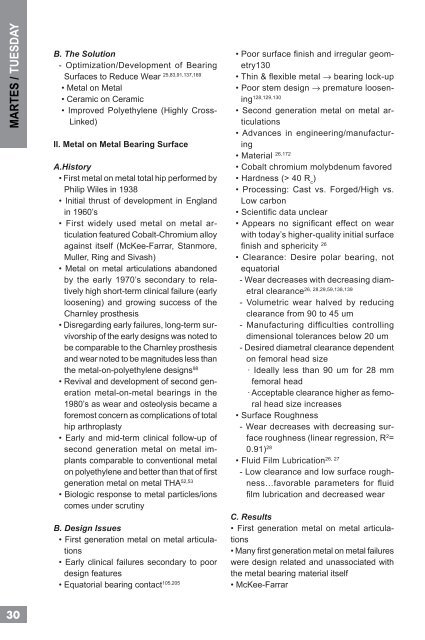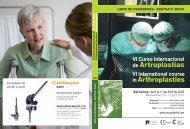cadera / hip - Active Congress.......
cadera / hip - Active Congress.......
cadera / hip - Active Congress.......
Create successful ePaper yourself
Turn your PDF publications into a flip-book with our unique Google optimized e-Paper software.
MARTES / TUESDAY<br />
30<br />
B. The Solution<br />
- Optimization/Development of Bearing<br />
Surfaces to Reduce Wear 25,83,91,137,169<br />
• Metal on Metal<br />
• Ceramic on Ceramic<br />
• Improved Polyethylene (Highly Cross-<br />
Linked)<br />
II. Metal on Metal Bearing Surface<br />
A.History<br />
• First metal on metal total <strong>hip</strong> performed by<br />
Philip Wiles in 1938<br />
• Initial thrust of development in England<br />
in 1960’s<br />
• First widely used metal on metal articulation<br />
featured Cobalt-Chromium alloy<br />
against itself (McKee-Farrar, Stanmore,<br />
Muller, Ring and Sivash)<br />
• Metal on metal articulations abandoned<br />
by the early 1970’s secondary to relatively<br />
high short-term clinical failure (early<br />
loosening) and growing success of the<br />
Charnley prosthesis<br />
• Disregarding early failures, long-term survivors<strong>hip</strong><br />
of the early designs was noted to<br />
be comparable to the Charnley prosthesis<br />
and wear noted to be magnitudes less than<br />
the metal-on-polyethylene designs 98<br />
• Revival and development of second generation<br />
metal-on-metal bearings in the<br />
1980’s as wear and osteolysis became a<br />
foremost concern as complications of total<br />
<strong>hip</strong> arthroplasty<br />
• Early and mid-term clinical follow-up of<br />
second generation metal on metal implants<br />
comparable to conventional metal<br />
on polyethylene and better than that of fi rst<br />
generation metal on metal THA 52,53<br />
• Biologic response to metal particles/ions<br />
comes under scrutiny<br />
B. Design Issues<br />
• First generation metal on metal articulations<br />
• Early clinical failures secondary to poor<br />
design features<br />
• Equatorial bearing contact 105,205<br />
• Poor surface fi nish and irregular geometry130<br />
• Thin & fl exible metal → bearing lock-up<br />
• Poor stem design → premature loosening128,129,130<br />
• Second generation metal on metal articulations<br />
• Advances in engineering/manufacturing<br />
• Material 26,172<br />
• Cobalt chromium molybdenum favored<br />
• Hardness (> 40 R ) c<br />
• Processing: Cast vs. Forged/High vs.<br />
Low carbon<br />
• Scientifi c data unclear<br />
• Appears no signifi cant effect on wear<br />
with today’s higher-quality initial surface<br />
fi nish and sphericity 26<br />
• Clearance: Desire polar bearing, not<br />
equatorial<br />
- Wear decreases with decreasing diam-<br />
26, 28,29,59,138,139<br />
etral clearance<br />
- Volumetric wear halved by reducing<br />
clearance from 90 to 45 um<br />
- Manufacturing diffi culties controlling<br />
dimensional tolerances below 20 um<br />
- Desired diametral clearance dependent<br />
on femoral head size<br />
· Ideally less than 90 um for 28 mm<br />
femoral head<br />
· Acceptable clearance higher as femoral<br />
head size increases<br />
• Surface Roughness<br />
- Wear decreases with decreasing surface<br />
roughness (linear regression, R2 =<br />
0.91) 28<br />
26, 27<br />
• Fluid Film Lubrication<br />
- Low clearance and low surface roughness…favorable<br />
parameters for fl uid<br />
fi lm lubrication and decreased wear<br />
C. Results<br />
• First generation metal on metal articulations<br />
• Many fi rst generation metal on metal failures<br />
were design related and unassociated with<br />
the metal bearing material itself<br />
• McKee-Farrar





